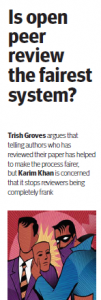BJSM is transparent about its peer-review process. We receive 1000 papers a year and can only publish about 10% of them. So 60% of papers are returned to authors after the editorial team has reviewed them. Who’s the editorial team? It’s Karim Khan, Babette Pluim and Jill Cook. So these are called ‘rejected without external review’. This should happen within a week of submission so the good news is that if the paper doesn’t look like having a chance to get into BJSM, authors have it back without delay.
Today, I’ll focus on what it takes to get through that first hurdle – to have a paper sent for external review. BJSM’s mission is to provide clinically useful material for clinicians the world over. Our summary slogan could be ‘clinically-relevant’ and ‘global/international’. Will your paper influence practice or policy in sport and exercise medicine? There are many ways to do that so we have a broad scope. Our member societies include BASEM, AMSSM, ECOSEP and the Swiss Sports Physiotherapy Association so papers should be of interest to those readers.
We are also endorsed by sports and exercise medicine societies in South Africa (SASMA), Australia and New Zealand (ACSP) so BJSM has wide reach. Our plan to focus on clinical relevance came after consultation with folks from all our member societies. We are executing a strategy which has us aiming to provide multimedia value to clinicians as they practice every day and work with active individuals in various settings. (Hence the videos and podcasts on the home page).
Sports clinicians are involved in public health so papers about physical activity and health are clearly relevant. Papers that will influence decision-makers in the field of exercise and health are also important. Data that will help teams perform better in relation to health issues are grist for the mill. But if you have a new ‘play’ in basketball that would fit better in a coaching or coaching science journals.
If you are interested in the peer-review process, see the BMJ ‘Head to Head’ (two articles, one for, one against ‘open’ peer review). Also, BJSM has a take on innovation and the problems that researchers have in challenging conventional thinking.
I’ll clarify this more about BJSM’s process in the next few days among our other blog topics. Feel free to ask questions or to comment.
